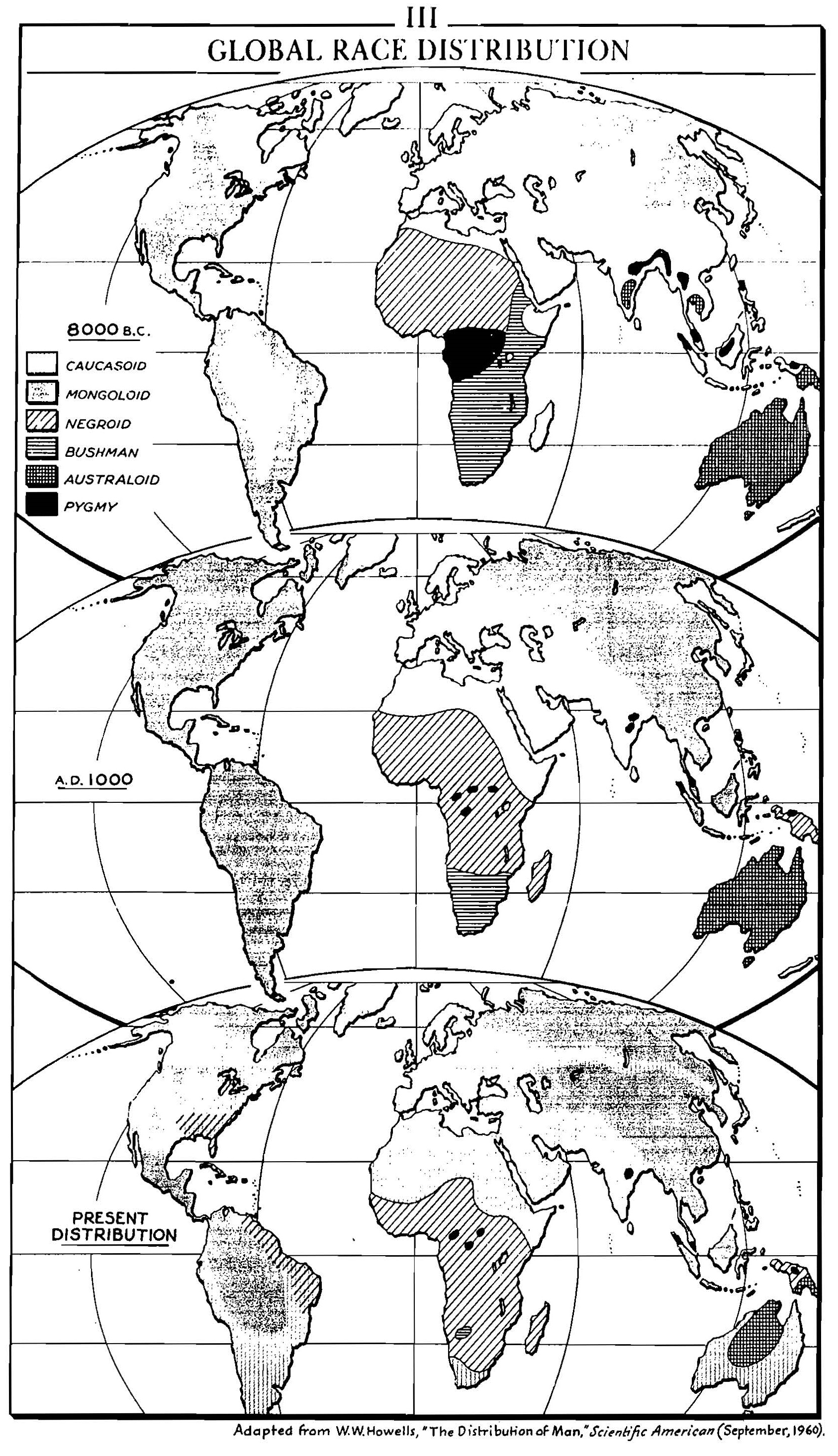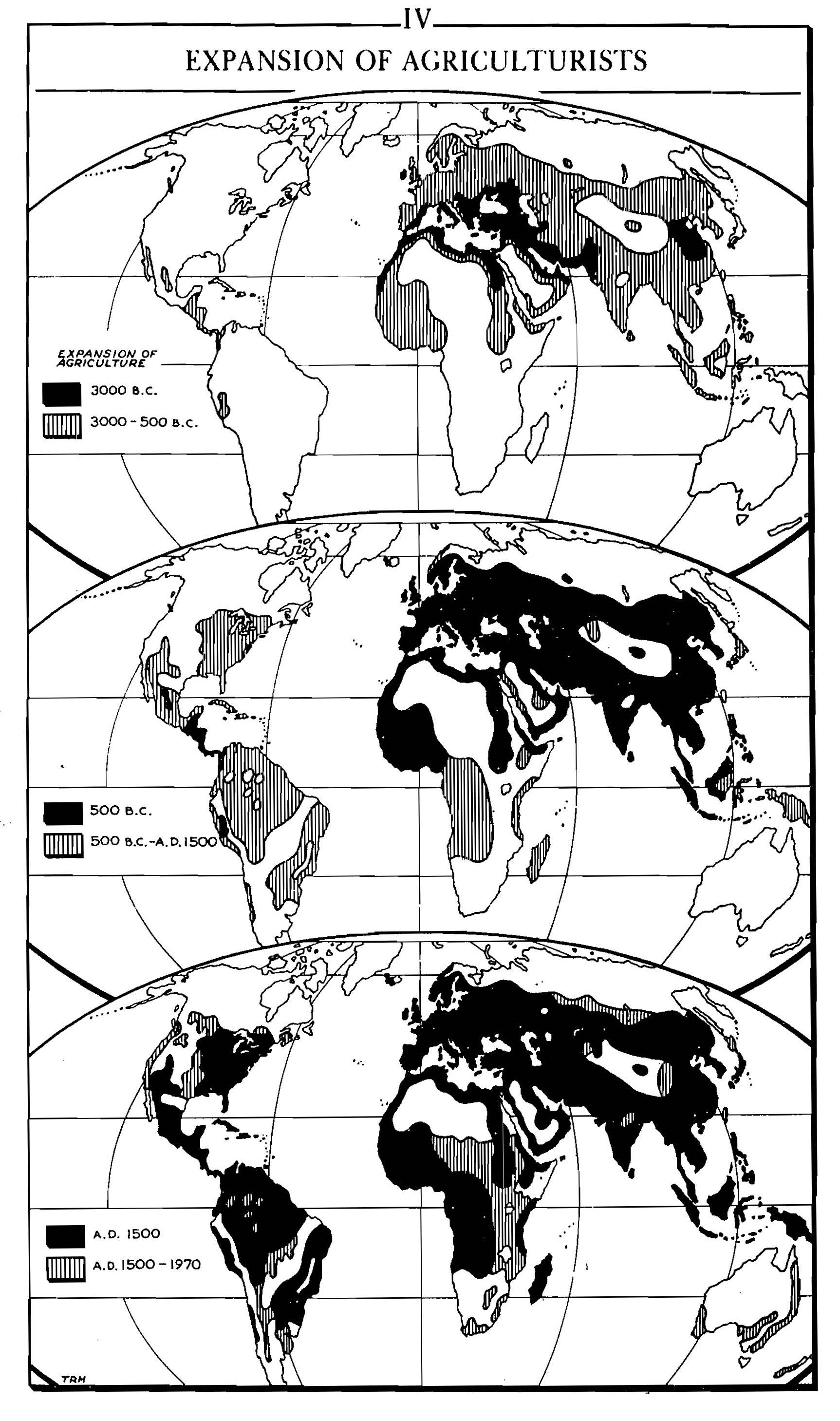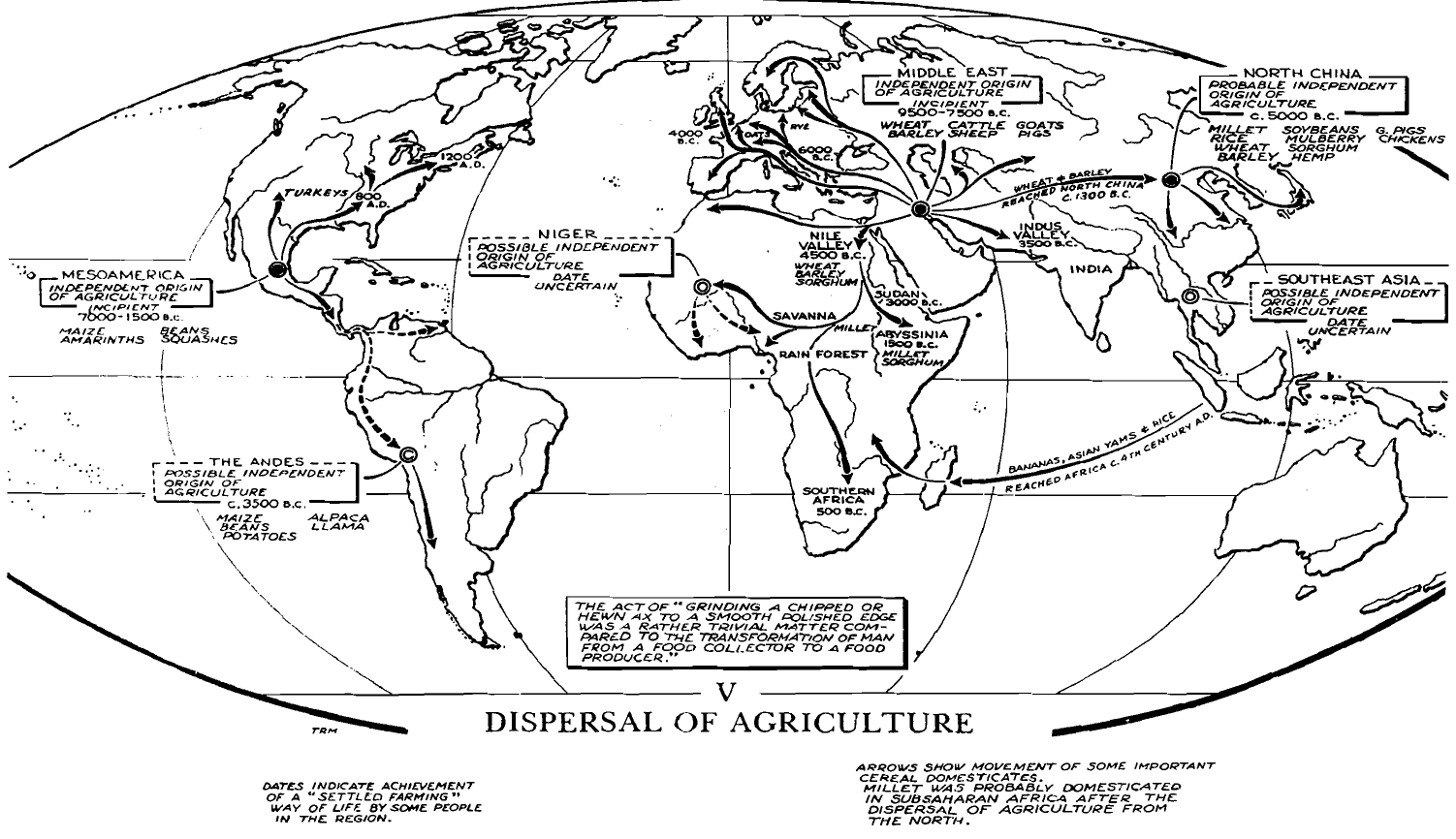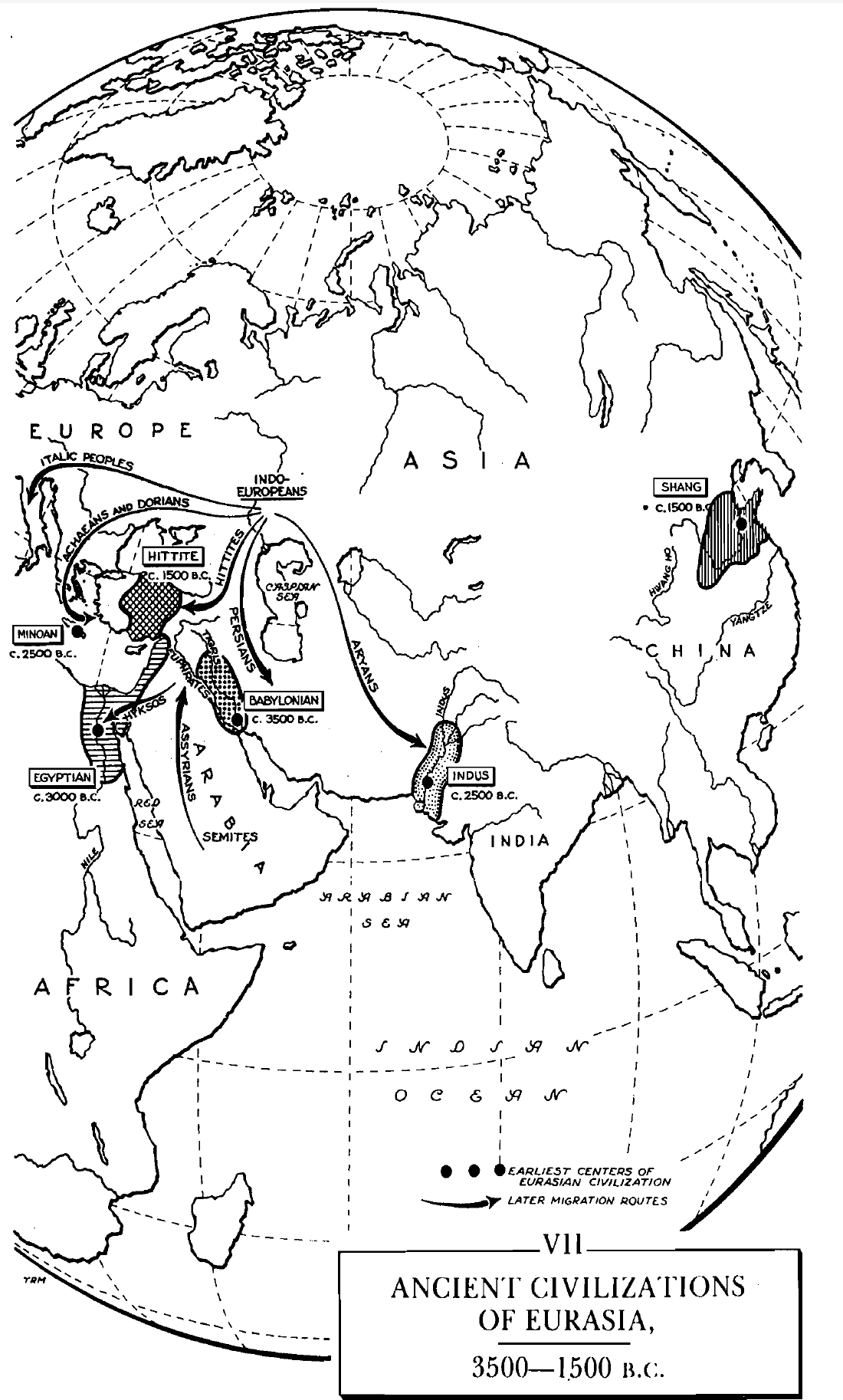A Global History (Stavrianos)
Contents
A global history: from prehistory to the present, English version, 5th edition.
Preface
The book is distinctive in three ways:
- Connects the past to the present
- Also connects the present and the future
- History is a science and offers some predictability
- Deals with a world history
- World history is not the sum of histories of civilizations of the world, rather is about the historical forces that affects the world as a whole.
Book 1 (before 1500):
- Paleolithic times
- Neolithic period; agriculture
- The Eurasian civilizations
Book 2 (after 1500): the Western European expansion
- The roots of European expansion
- The Confucian, Moslem and non-Eurasian worlds on the eve of Europe’s expansion
- The stages of European expansion
Part 1: Before Civilization
Focuses:
- From hominid to Homo sapiens (“thinking human being”)
- From food gatherer to food producer
Chapter 1: Humans As Food Gatherers
From Hominids to Humans
Hominids (mainly Australopithecus)
- 4 million years ago
- Walking erect on two legs
- 1/3 cranial capacity of a modern human
Homo erectus
- 2/3 brain capacity of human
- Make and use tool (e.g., hand axe)
- Social life:
- Large-scale hunting of big games – group organization, speech communication
- Ritual burial – reverence for the dead
- Decorative sense
- Use of fire $\rightarrow$ able to spread throughout the globe
Homo sapiens
- 40,000 years ago
- “Blade technique” – tools to make tools
- Sewn skin garments
Life of Food Gatherers
- Social organization
- Autonomous band of 20-50 persons
- Family is the basis
- Social relations
The essence is cooperation (for their bare existence)
- Rare polygamy – sex equality
- Social equality
- Economic cooperation
- Relation with nature and the supernatural
- Static, ahistorical views and way of thinking
- Lack explanatory knowledge; cannot naturalistically explain phenomena
- Specialists of ritual: shaman
Appearance of Races
- Major technological breakthrough $\rightarrow$ population explosion
- Early Paleolithic: 125,000 hominids; the end of the Paleolithic: 5.32 million; over $42 \times$
- Population explosion $\rightarrow$ spread over larger areas
- Australopithecus (hominid): within Africa savanna lands
- Homo erectus: Africa $\rightarrow$ temperate zones of Eurasia; Java man, Peking man, Heidelberg man
- Homo sapiens: Siberian tundra, African & Southeast Asian tropical rain forests
- Dispersal $\rightarrow$ race differentiation
- Happens late in time; all modern races “stem from a common stock”; able to interbreed, and “no significant differences in innate mental capacity among all races.”

Race distribution
Chapter 2: Humans As Food Growers
(Earlier) Paleolithic times: human learned to speak, to make tool, and to use fire; akin to animals, humans were still food gatherers.
Origins of Agriculture
- Agriculture: start of Neolithic age.
- Paleolithic humans understood the mechanics of plant growth; they didn’t grow crops because
- There’s no incentive: humans were not starving or suffer from population explosion
- Humans as hunters and gatherers had a greater variety of food, can work less, and can avoid unsanitary conditions due to settling down.
- Plants and animals suitable for domestication is scarce.
- Shift to agriculture: 10,000 $\sim$ 2,000 years ago
- No more places to migrate to $\rightarrow$ population density increases
- Many more people per square mile can be supported by agriculture than by food gathering.
Spread of Agriculture
- (Independent) center of agricultural revolution:
- the Middle East: wheat, oats, rye, and barley; goat, sheep, cattle, and pig
- Mesoamerica: maize, beans, squashes
- Northern China: millets, sorghum, soybeans, mulberry tree, lacquer tree
- Other centers suggested by new discoveries
- Multi-species agriculture: higher productivity + subsistence security
- Incipient agriculture: earliest domestication to agricultural revolution
- Gradual and prolonged; several millennia

Expansion of Agriculture
- Diffusion of agriculture is sparked by the inefficiency of early agriculture
- Land is used for a few years $\rightarrow$ abandoned to restore fertility for $8 \sim 10+$ years
- Recuperating land $:$ cultivated land is $5 \sim 10 : 1$
- Constant shift-off from settlement to new lands
- Middle East: spread to Indus valley, central Asia, eastern Europe
- Africa: (most likely) from Middle East $\rightarrow$ Nile valley (4000 B.C.) $\rightarrow$ Sudan Negroes (3000 B.C.) $\rightarrow$ sub-Saharan Africa
- New world: maize in Mexico, 7000 B.C.; two species of squash, the bottle gourd, tepary bean, chili peppers, amaranths, and avocados.

Agriculture dispersal
Varieties of Agriculture
- Three cereal areas (very generally speaking)
- the rice area in East and Southeast Asia
- the maize area in the Americas
- the wheat area in Europe, the Middle East, North Africa, and central Asia to the Indus and Yellow River valleys
- Agricultural techniques / styles
- Slash and burn: remove trees without iron tools
- Terrace agriculture: prevent the damage of flash floods in mountainous areas
- Vegetative root farming
- Raised field agriculture (in Peru)
- Stock raising
- In regions with too little rainfall for agriculture
- Pastoral nomads with their dogs, horses, camel … – always ready to strike the civilization centers
Life of the Food Growers
- Settle down to grow plants – bands gave way to villages
- Life was miserable in the beginning:
- Low productivity
- Hard labor and famine, malnutrition
- Sanitation problems Higher birthrate compensated for low life expectancy
- Rapid technological progress
- Sedentary life enabled a richer material existence
- House furnishing, pottery, ovens (kilns), textiles…
- Social structure:
- Tribal political structure; tribes, chiefs
- Extended family consisting of two or more couples and their children
- Social homogeneity
- A “built-in brake” on productivity
- Egalitarian, but low productivity
- Equality in social relations, and in sex relations
- Religion
- A goddess of the earth or of fertility; the earth mother The source of productivity of plants and animals, and of the fecundity of women
Demographic and Racial Results
- Human population: 5.32 million (10,000 BC) $\rightarrow$ 133 million (2,000 BC)
- Agriculture spreads long distance and converts hunters into agriculturalists
- Race imbalance: Mongoloids, Caucasoids, Negroids outstand in number
Highlights
The three turning points of life events on this planet
Viewed In the broadest perspective, this development represents the second major turning point in the course of events on this planet.
The first occurred when life originated out of inorganic matter. After that momentous step, all living forms evolved by adapting to their environments through mutation and natural selection. That is, the genes adapted to the environment, as was evident during the climatic upheavals of the Pleistocene.
But with the appearance of humans, the evolutionary process was reversed. No longer did genes adapt to environment; instead, humans adapted by changing the environment to suit their genes.
Today, a third epochal turning point appears imminent as humans' growing knowledge of the structure and function of genes may soon enable them modify their genes as well as their environment.
Culture is a way of dealing with environment without mutations
The other way is mutations of course – the one method that was given to all species; also (perhaps soon) we’ll have a third way of doing so, by genetic editing.
These correspond to the three major phases of life events above.
Humans, and only humans, have been able to create a made-to-order environment, or culture, as it is called.
The reason is that only humans can symbolize, or envision things and concepts divorced from here-and-now reality. Only humans laugh, and only they know that they will die. Only they have wondered about the universe and its origins, about their place in it and in the hereafter.
With these unique and revolutionizing abilities, humans have been able to cope with their environment without mutations. Human culture became the new, non-biological way of having fur in the arctic, water storage in the desert, and fins in the water.
More concretely, culture consists of tools, clothing, ornaments, institutions, language, art forms, and religious beliefs and practices. All these have served to adapt humans to their physical environment and to their fellow humans. …
Paleolithic social relation is cooperative and communal … with reasons
“So the equality of our Paleolithic ancestors was not due to superior morals. Greed was absent because nobody could profit from it.”
… Since they were always on the move, no members could gain by accumulating more than others. They would only have to leave everything behind when the band moved to the next campsite after having exhausted local food resources.
So the equality of our Paleolithic ancestors was not due to superior morals. Greed was absent because nobody could profit from it.
Primitive humans and the supernatural
- Static, ahistorical views
- Creation myths
- Not able to naturalistically explain phenomena
… primitive humans were basically ahistorical and non-evolutionary in their attitudes toward themselves and their society. They assumed that the future would be identical to the present, as the present was to the past.
Consequently there was no notion of change, and hence no inclination to criticize or to tamper with existing institutions and practices. To their way of thinking, everything, including themselves, their culture, and their habitat, had appeared with the creation and was destined to continue unaltered into the future. The creation myths of hunting peoples are strikingly similar, involving heroes who fashioned the landscape, stocked it with game, brought forth the people, and taught them the arts and their customs.
Not knowing how to cope with nature by naturalistic means, they had to resort to the supernatural. They turned to magic and spent much time in efforts to persuade or fool nature into yielding a greater abundance.
All modern races stem from a common stock
All modern races, then, stem from a common stock, and after it had attained its full human development. This explains why the Europeans were able to interbreed with all races in all the lands they discovered. It also explains why, as virtually all anthropologists agree, there are . Representatives of late Paleolithic or of the contemporary Australian aborigines would stand as much chance of graduating from a university as would representatives of any other living races.
What These Means for Us Today
Are human beings aggressive or cooperative by nature? Neither.
Arguments in both direction have been made, and proofs for either side has been found. The tribe of Tasaday is marked for their complete lack of aggressiveness, while Fentous are generation after generation fierce fighters. This highly suggests that a preference for peace or war is not nature, but nurture.
This question is critical because, as a part of the technology leaps, we are becoming increasingly likely to destroy ourselves. Wars have become more deadly as well as more frequent. The Paleolithic period did not see many wars because there are not much to gain in fighting, and too much to lose – might just be the whole humanity – over not cooperating to deal with the harsh nature. Over time there came more incentives to fight over more assets, and the ways of killing became more advanced.
It’s important to see that war is not inevitable – because it’s in the culture, not the nature – but something needs to be done.
Part 2: Classical Civilization of Eurasia, to A.D. 500
Focus: classical civilizations in classical age
- Prevalent creativity in different civilizations, each developing its own style (Unlike agricultural revolution, in which the Middle East took the major lead)
- Outward expansion, contact with each other
Chapter 3: First Eurasian Civilizations, 3500 - 1000 B.C
- Earliest: Sumer, “the land of Shinar”, on Mesopotamia (current-day Iraq), around 3500 B.C.
- The conversion from tribalism to civilization is not an event (immediate) but a process (over time), and 3500 B.C is an estimation.
Civilization
Civilization is a rough concept supported by several characteristics (criteria) that not all civilizations exactly satisfies, including:
- Urban center
- Institutionalized political authority in the form of the state
- Tribute or taxation
- Writing
- Social stratification into classes or hierarchies
- Monumental architecture
- Specialized arts and sciences
How Ancient Civilizations Began
Examine how the chain reaction happened in the Middle-East, from the tribal society on the hills over Tigris-Euphrates, to what is now known as the Akkadian Empire.
People are moving down to the river valley from the hills. This new environment imposed some challenges such as inadequate rainfall, searing heat, periodic floods, and lack of stone for building, but there were advantages that far outweighed the difficulties.
In this period, difficulties of the new environment stimulated new technologies, which in turn more than compensated for the difficulties.
Irrigation: Farmers began to dug short canals from the river to their field to compensate for the lacking rainfall. Irrigated, the rich alluvial soil in the valley yielded an incredibly large amount of crops compared to before.
Metallurgy: due to the lack of flint in the valley. Started from copper which has a low melting point, and over time, it was found that adding tin to copper increases the durability of the resulting metal. This is the bronze.
Powers other than muscle power came into use. A simple form of plow emerged, powered by a pair of oxen; on the sea, wind power was harnessed for water transport.
Institutional changes came hand-in-hand with these technological changes, and this is a reciprocal process.
Class differentiation started from the priests, who were successors of the old-day shaman. Shaman had been highly influential in the tribal villages due to the importance of agricultural ceremonies, but that wasn’t a full-time position. Now, simply put, the growth in food surplus freed a part of people from agricultural production – here the priests – thus giving form the a full-time priesthood.
Priests started to bear more managerial responsibilities, keeping records for major events such as the annual floods (inventing writing along the way), which in turn contributed to economy and technology. Priesthood also stimulated craft, which was mainly designed for the temples. This was a time when both the scale and the heterogeneity of the society was growing.
The efficacy of religious sanction diminished in the unprecedentedly large and complex towns. Warfare was growing in scale and frequency due to population growth, and the wealth of temples attracting raids possibly contributed as well. As a result, the status of religious elite were undermined.
In the meantime, as the frequency of wars was increasing, and period of peace shrinking, the tenure of war leaders became longer, until finally they were ensconced as permanent military chiefs, and eventually as kings.
The palaces came to rival the temples, and there came the tense working partnership between secular kings and religious elites. (which is a recurring theme in the following many centuries, as we all more or less know what unraveled in the Europe continent…)
Secular states stimulated more need of non-agricultural commodities and led to an increase in its production. Luxury commodities in great quantity were absorbed by the growing palace retinues; increasing militarization required armaments on an unprecedented scale.
This increasing production incurred an increasing need for raw materials, such as minerals and timbers, which had to be brought from outside. Local products were exported in exchange, and yet another option was to conquer the conquer the sources of the needed raw materials.
Again the enlarging of military and palace establishments were reciprocal. The cost of this undermined the traditional assemblies, who then were increasingly bypassed a permanent, hereditary royal authority. Here comes the centralization of political power. This then led to more class differentiation, which we can tell by looking at the graves.
How Ancient Civilizations Spread
This was a time when civilization extended outwards, claiming and transforming uncivilized regions, replacing the tribal societies. They were replaced because they could not compete with civilizations that were much more productive. These class societies squeezed taxes and rents out of the peasants to the higher classes, and the peasants had to work infinitely harder than did the tribal cultivators.
The civilizations on the banks of the Tigris-Euphrates, the Nile, the Indus, and the Yellow river all underwent similar expansion and spread. By the time of Christ it extended with virtually no interruption from the English Channel to the China Sea.

Spread of civilizations
In the same way 3500 B.C. is estimated as the dawn of civilization on Mesopotamia, time may be given for other centers of civilizations:
- In Egypt, about 3000 B.C.
- In the Indus valley, about 2500 B.C.
- In the Yellow River valley of China, about 1500 B.C.
- In Mesoamerica and Peru, about 500 B.C.
Styles of Civilizations
First up, what was in common of all the civilizations? Inequality.
Social inequality: it was common for peasant / workers to be treated rather harshly. They suffered from heavy labor, malnutrition, and thus generally worse health condition and shorter lifespan, and their labor went to the upper classes in the form of taxes, rents, and labor services.
Sex inequality: women gradually fell out of being equal food producer as men, as the new agriculture became less suited for women – either because it was too heavy or because it kept them away from the children too long.
Woman subsequently were left home to do the “inside work” – the first time there was a distinction between “inside” and “outside” work – and became dependent, and thus secondary.